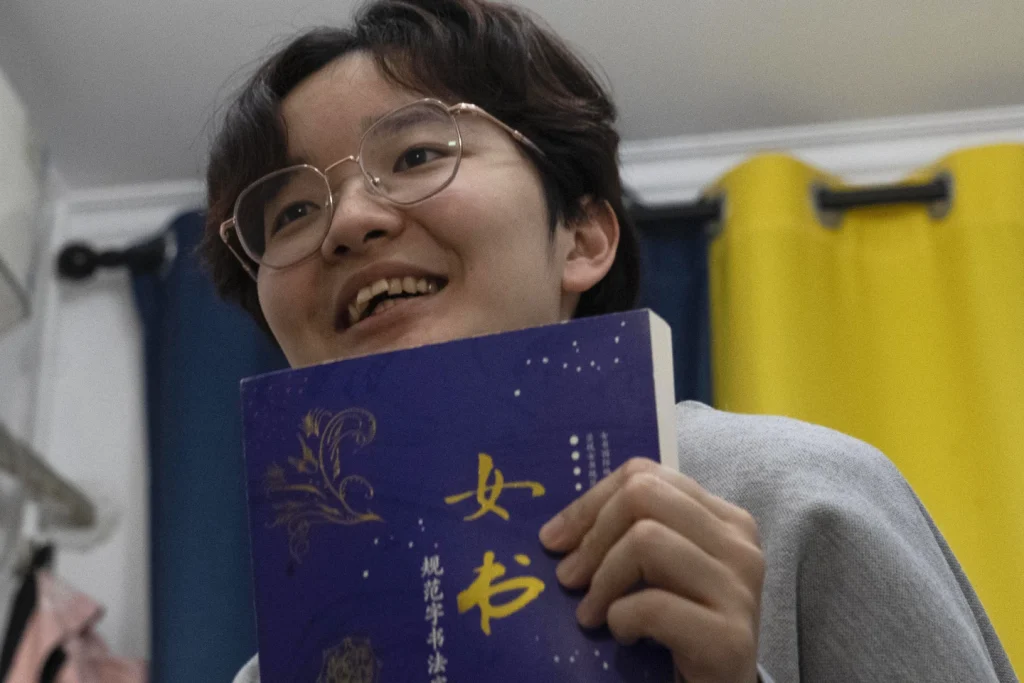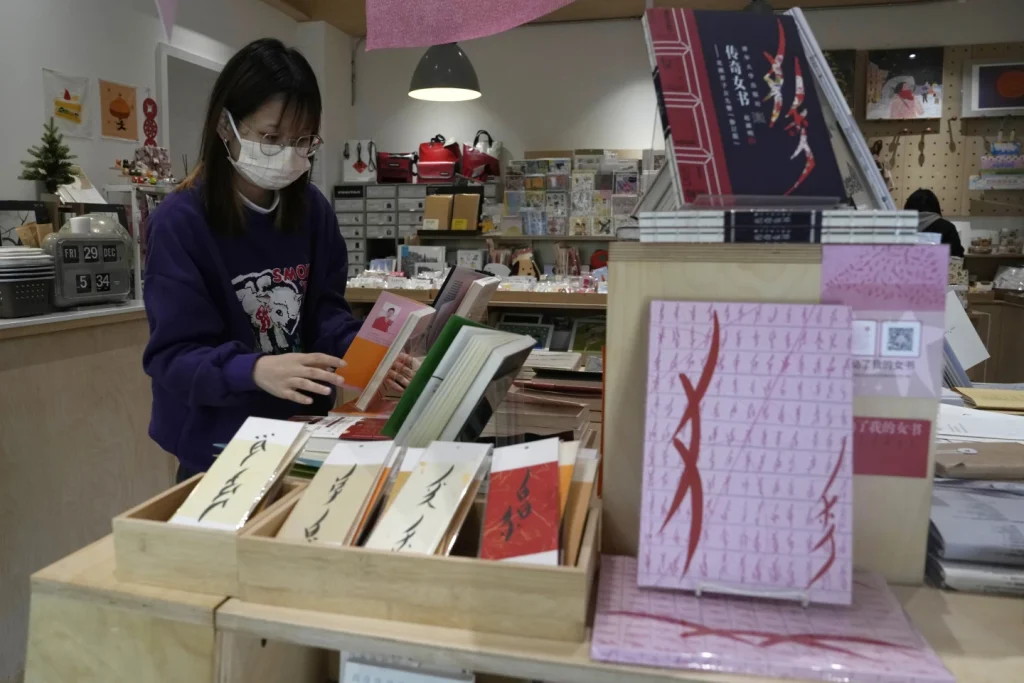In recent years, a remarkable cultural revival has taken place, centering around a script known as nüshu, which has become not only a symbol of heritage but also a powerful tool for empowerment among young women in China.
The story of Chen Yulu, a 23-year-old ambassador of nüshu, exemplifies the profound impact this ancient script has on contemporary society, particularly in challenging patriarchal norms.
Nüshu, originating from the rural county of Jiangyong in Hunan province, was historically a mode of communication among women, developed in a context where access to formal education was reserved predominantly for men.
This script, which combines elements of aesthetic beauty with an intriguing linguistic structure, was utilized by women to express their personal stories and emotional struggles—largely in secrecy—during a time when their voices were largely suppressed.
The history of nüshu stretches back centuries, encapsulating the lives and sorrows of women who faced oppression and isolation within a male-dominated society.
Scholars believe that the script emerged as early as the late Qing Dynasty, at a time when the harsh realities of traditional Chinese societal structures dictated women’s roles and capabilities.
Xu Yan, a 55-year-old advocate for nüshu and author of a relevant textbook, reflects on this context succinctly: “You won’t allow me to go to school.
Okay, I get it. So what’s my way out? I’ll find ways to educate myself.” This statement resonates powerfully, portraying a determined response to systemic exclusion.
Today, the demographic landscape has shifted significantly. Young individuals like Chen Yulu are reclaiming this once-forgotten form of communication as a vehicle for cultural and personal expression.
In an era where women’s rights and gender equality are increasingly being discussed, nüshu serves as both a historical testament and a contemporary rallying cry. Chen, who has a background in photography, found resemblances between her struggles in the art world and those of women who initially used nüshu.
Faced with skepticism from male professors about her capabilities, she channeled her frustrations into discovering the rich heritage of nüshu. “I felt that I had received a very strong power,” Chen stated, recognizing that many women share a similar yearning for empowerment.
The aesthetic characteristics of nüshu also contribute to its current renaissance. The script is noted for its softly flowing forms and the emotional depth it captures, offering a contrast to the rigid structure of Standard Chinese characters.
Not only does nüshu find its way into independent bookstores, art installations, and fashion accessories, but it has also become a part of a larger dialogue revolving around feminism and women’s history in modern China. Its presence in tattoos and craft fairs is a testament to its evolving symbolism, reflecting personal narratives and communal solidarity.
Interestingly, the “third-day letter,” a practice in which a hand-sewn book was presented to a bride following her marriage, demonstrates how the script facilitated the expression of communal bonds and emotions, transcending the limits of social constraints.
This tradition is emblematic of the way nüshu creates a narrative that unites women, fostering an environment where they can share their sorrows and joys in relative privacy, away from the prying eyes of a judgmental society.
Nüshu’s resurgence is also significant in that it breathes life into discussions about femininity and collective identity.
As contemporary advocates for women’s rights gain traction in various spheres, parallels can be drawn between the struggles of past generations and the present-day quest for gender equality.
By tapping into this historical context, young women like Chen Yulu are empowered to challenge the status quo and articulate their experiences.
The exploration of cultural artifacts often reveals intricate layers of meaning, particularly in the context of gender and societal structures. One such artifact is nüshu, a script developed and traditionally used by women in Jiangyong County, Hunan Province, China.
This unique form of writing serves not only as a means of communication but also as a poignant reflection of the duality of women’s experiences—painful yet empowering.
The documentary featuring He Yanxin, a formally designated inheritor of nüshu, provides a compelling lens through which to examine this duality. The contrasting views expressed by He and Chen, another participant in the documentary, illuminate the complexities surrounding the script and its implications for women today.
At first glance, He Yanxin’s assertion that “nüshu is useless” appears to undermine the value of a script that has historically been a medium for women to express their thoughts, emotions, and experiences.
He’s personal narrative, marked by forced marriage and abuse, casts a shadow over the script’s perceived utility. Her life story underscores a painful reality: despite the existence of a cultural artifact designed to empower women, it did not shield her from the harshness of patriarchal oppression.
The tearing of photographs from nüshu meetups and workshops by her abusive husband symbolizes not merely a physical destruction of memories but an erasure of the very community and strength that the script represents.
This painful history complicates the notion of nüshu as a tool for empowerment, suggesting that cultural expressions can coexist with systemic oppression.
Conversely, Chen’s experience offers a different perspective, one that emphasizes the potential of nüshu as a source of strength. Despite her own struggles, she has dedicated herself to revitalizing and disseminating the script, starting an online nüshu group and conducting workshops across China.
Chen’s efforts demonstrate a profound commitment to reclaiming and redefining the narrative surrounding nüshu. Her assertion that “nüshu has use” speaks to the script’s ability to foster community, provide solace, and serve as a vehicle for resistance against traditional gender roles.
By encouraging others to learn and engage with the script, Chen transforms what she perceives as a painful legacy into a platform for empowerment and sisterhood.

The generational shift in the understanding of nüshu is further exemplified by the experiences of young women like Lu Sirui. Initially introduced to the script through feminist online communities, Lu’s journey reflects a growing recognition of nüshu as a form of resistance against patriarchal norms.
Her realization that the script functions as a bond among women enhances its significance, positioning it as a tool for solidarity and rebellion. In a society where women often face gender-based violence and discrimination, the act of learning and practicing nüshu becomes an assertion of agency and identity.
Lu’s personal encounter with a threatening situation and her subsequent outreach to a feminist community illustrate the importance of collective support in navigating the challenges posed by a patriarchal society.
Moreover, Lu’s initiative to host workshops and promote the script in urban settings highlights the potential for cultural revival and reinterpretation.
Despite the initial unfamiliarity among participants, the positive feedback she receives underscores a latent desire for connection and empowerment among women. The act of gathering to learn and practice nüshu transcends mere literacy; it embodies a collective assertion of female strength that resonates across time and space.
Lu’s perspective frames nüshu not just as a historical artifact, but as a living tradition that continues to evolve and serve contemporary needs.
The duality of nüshu, as both a painful remnant of women’s oppression and a source of empowerment, invites a deeper examination of how cultural practices can be reinterpreted to foster resilience.
While He Yanxin’s experiences remind us of the limitations and challenges that women have faced, Chen and Lu’s narratives illustrate the transformative power of reclaiming and redefining cultural expressions.
This dynamic interplay between pain and strength reflects a broader societal shift toward recognizing and valuing women’s voices and experiences, even in the face of adversity.
In conclusion, the exploration of nüshu through the lens of its inheritors and advocates reveals a complex tapestry of meanings. It serves as a reminder that cultural artifacts are not static; they are imbued with the experiences, struggles, and aspirations of those who engage with them.
As women like Chen and Lu continue to breathe new life into nüshu, they not only honor its legacy but also forge new pathways for collective empowerment.
The duality of the script—both a painful reminder of the past and a source of strength for the future—captures the essence of women’s resilience, illustrating that even in the darkest of times, the bonds of sisterhood and the quest for agency can illuminate the path forward.
